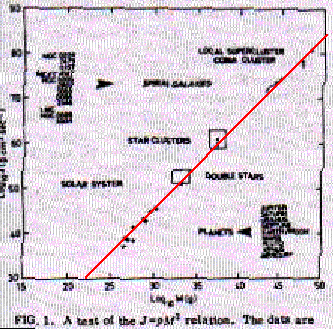
Angular Momentum J and Mass M are related by a constant p such that
J = p M^2 and J/M = p M.
Wesson's observations indicate, approximately, that
p = 10^(-16) g^(-1) cm^2 sec^(-1) (cgs units) and p = 1 / alpha_EM = 137 (natural units G = hbar = c = 1).
For Elementary Specific Angular Momentum J/M = hbar, in natural units where hbar = 1 and the unit of mass is the Planck mass Mplanck:
M = (J/M) / p = alpha_EM, which gives M = Mplanck / 137.
Mplanck / 137 is roughly the mass of an SU(5) GUT Magnetic Monopole.
Angular Momentum J and Magnetic Dipole Moment P are related by a constant that is on the order of unity ( J = P ) (natural units) due to Gravity-Induced Electric Polarization of matter.
Saul-Paul Sirag, in his 3 November 2000 paper Vigier III: "Gravitational Magnetism: an Update", says:"... The most straightforward test ... would be to measure directly the magnetic field of a rotating neutral body (which is not also a ferromagnetic substance). Blackett ... suggested that a 1-meter bronze sphere spun at 100 Hz would do nicely, except that this is the maximum safe speed, and there are severe problems in nulling out extraneous magnetic fields. With modern SQUIDs and mu-metal shielded rooms, such an experiment can be attempted. Exactly such an experimental design ... was described at the SQUID '85 conference in Berlin. However, the results of this experiment have not been published. ...".However, if the relationship is indeed due to Gravity-Induced Electric Polarization of matter, then the experiment would not only have to be shielded electromagnetically, but would also have to be done at Zero Gravity ( possibly in an Earth Orbit Laboratory ) so that the dominant gravitational force in the experiment would be due to the experimental object ( such as the 1-meter bronze sphere spun at 100 Hz suggested by Blackett and Sirag ) itself, and not due to an ambient gravitational field such as that at the surface of the Earth.
Paul Wesson plotted total angular momentum J against mass M for the solar system, double stars, star clusters, spriral galaxies, the Coma cluster, and the local supercluster:

Jack Sarfatti's paper wessonI.PDF contains an image (from which the above image is taken) from a 1981 paper by Paul Wesson. By fitting the red line to the data on Wesson's graph, it seems to me that there is a relationship J = p_wesson M^2 with a constant p_wesson whose value is
Some other angular momentum / mass relationships are:
In summary:
Consider a Compton Radius Vortex Kerr-Newman Black Hole related to the Wesson force. The equation (in units with G = c = hbar = 1) for a Kerr-Newman Black Hole with coincident outer and inner event horizons and with Q = 1
meaning that the Black Hole Core has UNIT amplitude to absorb or emit a gauge boson, in accord with Feynman's statement in his book QED (Princeton 1988): "... e - the amplitude for a real electron to emit or absorb a real photon. It is a simple number that has been experimentally determined to be close to -0.0854... the inverse of its square: about 137.03... has been a mystery ... all good theoretical physicists put this number up on their wall ..."
is Q^2 + (J/M)^2 = 1 + (J/M)^2 = M^2. Dividing through by M^2, you get
For the Wesson force for which J = p_wesson M^2 with p_wesson = 1 / alpha_EM
so that 1 - (1/M)^2 = 137^2 and 1/M = sqrt(1 -137^2) = 137 i = 137 exp(pi/2)
Then the magnitude | 1 / Mwesson | = 137 which (since the units are natural units with G = c = hbar = 1) implies that
which is consistent with the hypothesis that
Perhaps there is a Wesson force that is carried by a Mwessson particle. If so, since the strength of the gravitational force is ( 1 / (Planck Mass)^2 ) it seems to me that Wesson may be seeing a force whose strength is ( 1 / (Mwesson)^2 ) so that the ratio of the strength of the Wesson force to gravitation is
Note that 0.01 = 1/100 is roughly the Electromagnetic Fine Structure Constant alpha_EM which is at low energies 1/137.03 ... but which is closer to 1/100 at high energy levels.
Here are some more detailed plots of angular momentum against mass for astronomical objects, which more detailed plots use Specific Angular Momentum rather than total angular momentum (note that if total angular momentum J is propotional to M^2, then specific angular momentum J/M is proportional to M):
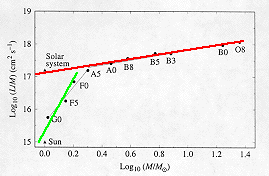
The above graph of Log(J/M) (cm^2/sec) against Log(M/Msun) of Specific Angular Momentum against Mass, (which denotes angular momentum by L instead of the J used here) from An Introduction to Modern Astrophysics, by Carroll and Osterlie (Addison-Wesley 1996), (with the red and green lines added), shows that for stars at least as massive as A5, most of the Angular Momentum of the star-forming cloud of dust and gas is preserved in the star itself. If the red line is continued to lower masses, such as for our Solar System, it shows you have to include the Orbital Angular Momentum of the Planets to account for the full amount of our Solar System Angular Momentum.
The green line for the Sun alone and other stars less massive than A5 lies below the red line, indicating that such stars may have Planets that carry some of the Angular Momentum of the star-forming cloud of dust and gas. The Sun (a G2 star) has 99.9% of its Mass, but only about 1% of its Angular Momentum, the bulk of which is in Orbital Angular Momentum of Jupiter and Saturn. Further, the Angular Momentum vector of the Sun is tilted 7 degrees with respect to the total average Planetary Orbital Angular Momentum.
What about the Planetary Rotational Angular Momentum?
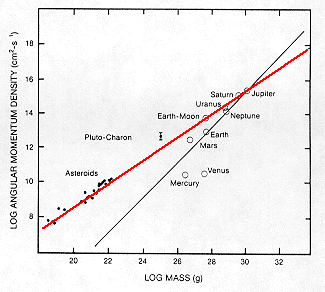
The above graph of Log(J/M) (cm^2/sec) against Log(M) (grams) of Specific Angular Momentum against Mass, from Solar System Evolution, by Stuart Ross Taylor (Cambridge 1992), (with the red line added), shows that the full Angular Momentum of the forming cloud of dust and gas is:
The Terrestrial Inner Planets alone seem to have less the full amount of the Rotational Angular Momentum of the forming cloud of dust and gas:
The Pluto-Charon system is unusual, and its total Angular Momentum (including Orbital) is somewhat more than would come from its forming cloud of dust and gas, if in fact it did form from a single cloud. Its excessive Angular Momentum may indicate that Pluto and Charon did not form from a single cloud.
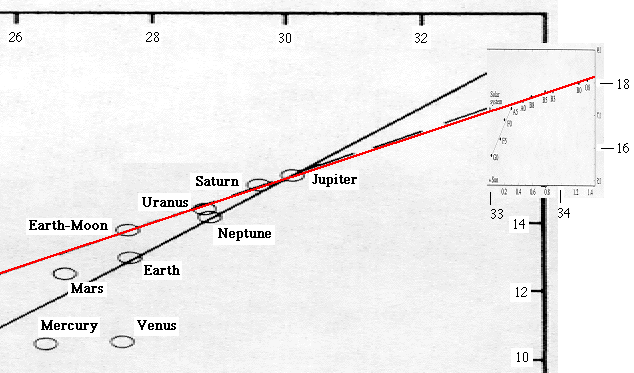
Anthony Peratt advocates taking account of electromagnetic/plasma phemomena in astrophysics in his book Physics of the Plasma Universe (Springer-Verlag 1992), which contains this figure describing the Jupiter-Io system:
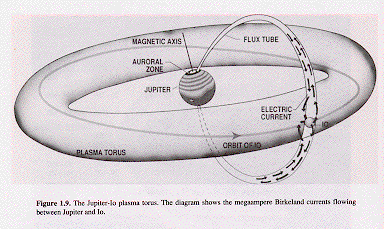
Kohji Tomisaka of Niigata University has written astro-ph/9911166, in which he says: "... the star formation process ... angular momentum transfer in the contraction of a rotating magnetized cloud is studied with axisymmetric MHD simulations. Owing to the large dynamic range covered by the nested-grid method, the structure of the cloud in the range from 10 AU to 0.1 pc is explored.First, the cloud experiences a run-away collapse, and a disk forms perpendicularly to the magnetic field, in which the central density increases greatly in a finite time-scale. In this phase, the specific angular momentum j of the disk decreases to about 1/3 of the initial cloud.
After the central density of the disk exceeds about 10^10 cm ^(-3) , the infall on to the central object develops. In this accretion stage, the rotation motion and thus the toroidal magnetic field drive the outflow.
The angular momentum of the central object is transferred efficiently by the out\flow as well as the effect of the magnetic stress. ... the seeding region (origin of the outflow) ... expands radially outward. This outflow is driven by the gradient of the magnetic pressure of the toroidal magnetic fields ... which are made by the rotation motion ... The magnetic fields exert torque on the outflowing gas to increase its angular momentum. On the other hand, they exert torque on the disk to decrease the angular momentum ... [in about 7000 years] ... the outflow expands and reaches ... [about 4 AU] ... The angular momentum distribution at that time ... has been reduced to ... a factor of 10 ^(-4) from the initial value (i.e. from 10^20 cm^2 s ^(-1) to 10^16 cm^2 s ^(-1)). ... the coupling between gas and magnetic fields ... becomes stronger as long as we consider the seeding region, indicating that the mechanism of angular momentum transfer works also in the later stage of the evolution [after 7000 years]. ...".
Solar Coronal Mass Ejections were probably much larger during the early stages of Solar System formation, as is indicated by Hubble Space Telescope observations of XZ Tauri
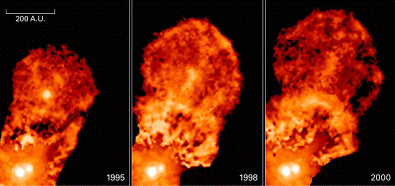
described in a 21 September 2000 article in Sky and Telescope, which said "... The huge Taurus-Auriga molecular cloud is the nearest large star-forming region, centered about 450 light-years away. It is full of newborn, highly variable stars with low or moderate masses that are surrounded by disks of gas and dust &emdash; how our Sun looked a few million years after its birth. One such star is million-year-old XZ Tauri, varying from 10th to 16th magnitude behind the Hyades. The Hubble Space Telescope resolved it into a binary star with a separation of at least 40 astronomical units ... An enormous spray of gas is erupting from the inner disk around one of the two stars (astronomers can't yet tell which) at 150 kilometers per second. The plume is only about 30 years old and grew substantially in just five years, as Hubble's series of images shows. The plume's rim brightened from 1995 to 1998, a sign that the rim was cooling and becoming less ionized and hence more able to emit light. ... As the outer bubble expanded and cooled a second seemed to be taking shape farther down its stem, perhaps a sign of repeated mass ejections. ...". Compare the size of present-day Solar phenomena.
Perhaps remnants of such an electromagnetic connection could account for such observations as
"It is worthy of note that in 1948 when Jupiter and Saturn were spaced by 120 degrees, and solar activity was at a maximum, radio signals averaged of far higher quality for the year than in 1951 with Jupiter and Saturn at 180 degrees and a considerable decline in solar activity. In other words, the average quality curve of radio signals followed the cycle curve between Jupiter and Saturn rather than the sunspot curve ..."
of J.H. Nelson, "Planetary Position Effect on Short-Wave Signal Quality" (Electrical Engineering, May 1952) as quoted in web pages of Richard Hoagland.
Although I do not agree with everything on Richard Hoagland's web pages, I do think that everything there is thought-provoking. As with all web pages, including mine, readers should think about the material and make up their own minds as to which parts of the material they think are substantially correct, which parts are not proven one way or the other, and which parts are substantially incorrect.
As Richard Hoagland notes, Jupiter has a 3x4 = 12 year sidereal period and Saturn has a 7x4 = 28 year sidereal period, so that they are in line with the Sun (on the same side of the Sun) every 7x3 = 21 years, which is the period of the Solar Magnetic Cycle. At mid-cycle, 10.5 years after its beginning they are on opposite sides of the Sun. The period between Jupiter and Saturn being in line on the same side of the Sun (0 degrees apart) and being in line on the opposite side (180 degrees apart) is 10.5 years, roughly the Sunspot Cycle.
The abstract of Douglas Torr and Ning Li, Foundations of Physics Letters 6 (1993) 371-383, says:
"... the carriers of quantized angular momentum in superconductors are not the Cooper pairs but [are] the lattice ions, which must execute localized motion consistent with the phenomenon of superconductivity.... in the presence of an external magnetic field, the free superelectron and bound ion currents largely cancel providing a self-consistent microscopic and macroscopic interpretation of near-zero magnetic permeability inside superconductors.
The neutral mass currents, however, do not cancel, because of the monopolar gravitational charge.
... coherent alignment of lattice ion spins will generate a detectable gravitomagnetic field, and in the presence of a time-depemdent applied magnetic vector, a detectable gravitational field.".
The Quantum Cavorite website of Pete Skeggs, discussing an article by Corey S. Powell in The May 1999 issue of Discover Magazine, says:
"...The interesting news is that Ning Li is still actively doing research, but is not publishing papers or results to avoid giving away her secrets to the competition. She claims to be gathering data that will change everything. ...".
The Kerr-Newman Black Hole structure of a Compton Radius Vortex has the property that the square of the electric charge Q plays the same role as the square of J/M (specific angular momentum, or angular momentum over mass) in that their sum, relative to the square of the mass, determines whether the outer and inner event horizons are
The extension of the Magnetic Dipole Moment relationships to the MacroScale of Asteroids, Planets, and Stars,
net Electric Charge relationships are only valid at the MicroScale of Elementary Particles, may be explained by Torr and Li when they say:
Jack Sarfatti relates Compton Radius Vortex structure of Elementary Particles to the formula of Saul-Paul Sirag (based on earlier work of Blackett and Schuster, and perhaps Pauli) in his 1979 Nature paper Gravitational Magnetism (vol. 278 pp. 535-538, 5 April 1979), in which Saul-Paul Sirag says:
"The gravi-magnetic hypothesis proposes that a rotating mass, measured in gravitational units, has the same magnetic effect as that of a rotating charge, measured in electrical units. The respective force constants determine this relationshipG^(1/2) M = k^(1/2) Qwhere G is the gravitational constant, M is mass, k is the Coulomb constant, and Q is electric charge.".
The MicroScale proportionality between Q and M obviously does not extend far into the MacroScale, since Asteroids, Planets, and Stars do not have large net Electric Charges.
However, there is a
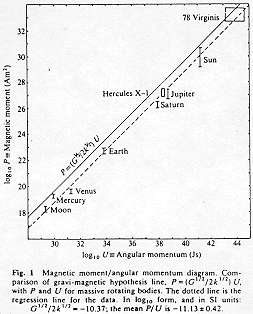
as shown in this figure, which is Fig. 1 of the paper Gravitational Magnetism (Nature 278 (5 April 1979) 535-538) by Saul-Paul Sirag (where he denotes angular momentum by U instead of the J used here). Note that
Saul-Paul Sirag says, in the Nature paper:
"... the magnetic fields (and angular momenta) of the earth and sun were known to come close to fitting this ratio [of proportionality of P to J].In 1947 Blackett was able to add the recent measurement of the magnetic field of the star 78 Virginis to this picture. ...
In ... [ the paper Gravitational Magnetism (Nature 278 (5 April 1979) 535-538, Saul-Paul Sirag adds] ... data of magnetic field measurements of the planets, and the pulsar Her X-1. These data fit the formula fairly closely with one notable exception -- Mars ... the best fit to the formula is Mercury ...".
As Saul-Paul Sirag says in the Nature paper (here I denote angular momentum by J instead of U as in the paper):
"... The gravi-magnetic hypothesis proposes that a rotating mass, measured in gravitational units, has the same magnetic effect as that of a rotating charge, measured in electrical units. The respective force constants determine this relationshipG^(1/2) M = k^(1/2) Q where G is the gravitational constant, M is mass, k is the Coulomb constant, and Q is electric charge.
Thus the ratio of magnetic moment P to angular momentum J for a sphere of mass M, density factor f, radius r, angular velocity w, and magnetic field B is (in SI units [with magnetic permeability muo of the vacuum]):
P / J = ( (5/4) 4 pi B / muo ) ( r / f w M ) = G^(1/2) / 2 k^(1/2) ... A priori, we should expect a correlation between P and J. ... The surprise is that this correlation ratio, P/J, should turn out to be close to P = ( G^(1/2) /2 k^(1/2) ) J. ...
... The gravi-magnetic hypothesis (stated in [ Log = log_10] form) predicts a P/J of -10.37.
The mean P/J of the data points plotted in Fig. 1 is -11.13 with a standard deviation of 0.42. ...".
Therefore, for a given value of the angular momentum J, the gravi-magnetic hypothesis overstates the magnetic dipole moment P by a factor of 10^(-10.37 - (-11.13)) = 10^0.76 = 5.75. Saul-Paul Sirag says:
"... the deviation from the gravi-magnetic hypothesis line is fairly systematic. ... deviations ... may well be due to electrical-magnetic effects. ...[ P / J = G^(1/2) / 2 k^(1/2) ] predicts a surface field about three times greater than that measured at the surface of the Earth. ... the Earth is not a uniformly dense sphere ...
At the Earth's surface ... [ ( (5/4) 4 pi B / muo ) ( r / f w M ) = G^(1/2) / 2 k^(1/2) ] predicts a B of 2.1 x 10^(-4) T.
That is not, however, a great deal more than the 1.4 x 10^(-4) T that [the equation] predicts for the surface of the Earth's core. ...
this core magnetism predicted by the gravi-magnetic equation is greater than the magnetic field of 6 x 10^(-5) T measured at the Earth's surface. ... This is what we expect if we suppose that gravitational magnetism is modified by an electrical-magnetic effect stronger at the Earth's surface than in the interior. ...".
Sirag uses MKS units that Feynman uses
in his 3-volume Lectures in Physics
(Feynman, Leighton, and Sands (Addison-Wesley 1963, 64, 65).
According to Feynman, in MKS:
G = 6.67 x 10^(-11)= 66.7 x 10^(-12) Newton m^2 / kg^2
k = 9 x 10^9 = 90 x 10^8 = Newton m^2 / Coulomb
and
sqrt(G) / sqrt(k) = ( sqrt(66) / sqrt(90) ) x 10^(-6 -4) =
= 0.856 x 10^(-10)
which is roughly what Sirag says in his 1979 Nature paper:
"... The gravi-magnetic hypothesis
(stated in [ Log = log_10] form)
predicts a P/U of -10.37. ...".
Sirag goes on to say:
"... The mean P/U of the data points
plotted in Fig. 1 is -11.13 ...".
Therefore,
the Sirag data plot indicates that, according to data:
P(Siragdata) / U = ( 1 / 5.75 ) sqrt(G/k)
Vasiliev's paper astro-ph/0002048, including Figure 2,
uses cgs magnetic units.
Using 10 Coulomb per emu,
(and using notation P for Vasiliev's mu and U for his L):
G = Gmks x (dyne/Newton) x (cm/m)^2 x (kg/gm)^2 =
= 6.67 x 10(-11) x 10^5 x 10^4 x 10(-6) =
= 6.67 x 10(-8) dyne cm^2 / gm^2
k = kmks x (dyne/Newton) x (cm/m)^2 x (Coulomb/emu)^2 =
= 9 x 10^9 x 10^5 x 10^4 x 10^2 =
= 9 x 10^20 dyne cm^2 / emu^2
and
sqrt(G) / sqrt(k) = ( sqrt(6.6) / sqrt(9) ) x 10^(-4 -10) =
= 0.856 x 10^(-14)
Vasiliev says, about the data plot in his Figure 2::
"... It is remarkable that the gyromagnetic relation of a star,
i.e.,
the relation of its magnetic moment to the angular momentum,
is expressed through world constants only
... [ P / U = sqrt(G) / 3 c ... (I changed his notation) ] ...
... As it can be seen from this figure
with the logarithmic accuracy,
all celestial bodies - stars, planets, and pulsars -
really have
the gyromagnetic ratio close to the universal value ..".
Vasiliev says that there is close agreement between data
and theory (that is, P/U = 1/3 in natural units),
while
Sirag says that there is a difference:
P/U = (1/5.75) x (sqrt(G)/2sqrt(k)) = (1/11.5) x sqrt(G/k).
Vasiliev does not have Sirag's factor of about 5.75 difference
between the gravi-magnetic theory value and the data value,
even though
Vasiliev says
"... The data for planets are taken from [16],
the data for stars are taken from [1],
and for pulsars - from [2]. ...",
and
Vasiliev's reference [16] is Sirag's 1979 Nature paper,
so that
the data lines are very similar.
However,
the Vasiliev theory line P/U = sqrt(G) / 3c (cgs magnetic units)
seems to me to be closer to the data line
than
the Sirag theory line P/U = sqrt(G) / 2 sqrt(k) (SI (mks) units).
B. V. Vasiliev, in his papers astro-ph/0002048 and astro-ph/0002171, says:
"... The calculations in Thomas-Fermi approximation show that in a gravitational field each cell of ultra dense matter inside celestial bodies obtains a very small positive electric charge.A celestial body is electrically neutral as a whole, because the negative electric charge exists on its surface.
The positive volume charge is very small, on the order of magnitude ... 10^(-18) e per atom only. ...
... It is remarkable that the gyromagnetic relation of a star, i.e., the relation of its magnetic moment to the angular momentum, is expressed through world constants only ... [magnetic moment / angular momentum] ... = sqrt(G) / 3 c ...
... The mechanism ... is based on ... gravity-induced electric polarization [GIEP] of matter. ... gravity induces inside a metal an electric field with an intensity
E = mi g / e ... where mi is the mass of an ion, g is gravity acceleration, e is the electron charge. This field is so small that it is not possible to measure it experimentally. It is a direct consequence of the presence of an ion lattice in a metal. This lattice is deformed by gravity and then the electron gas adapts its density to this deformation. ... the electrons form the degenerated Fermi gas.. ... a celestial body is electrically neutral as a whole, because the positive volume charge is concentrated inside the charged core and the negative electric charge exists on its surface and so one can infer gravity-induced electric polarization of a body. ...
... the action of gravity on matter is compensated by the electric force and the gradient of pressure is absent. ...
... According to early models, it was supposed that density of a substance inside celestial bodies grows more or less monotonically with depth and at the centre of a star, the density has the greatest value ... According to the developed theory, the density of a substance inside a star is constant. ...
... for a ... planet ... the ... stratum where ... polarization... [is] ... absent. ... can comprise a substantial part of a planet, and thus, only a small relatively internal region will be polarized. At the surface of this core, the electric field intensity falls to zero. ... Pressure affecting the matter inside this body is equal to the pressure jump at the surface of the core ...... it can be seen ... that the gyromagnetic relations of planets are also in the quite satisfactory agreement ... . The detailed calculation for the Earth gives for the magnetic moment ... almost exactly twice smaller than the measured value ... . Thus, it is possible to assume that the basic component of the magnetic moment of planets is induced by the same mechanism which is working in stars. ...
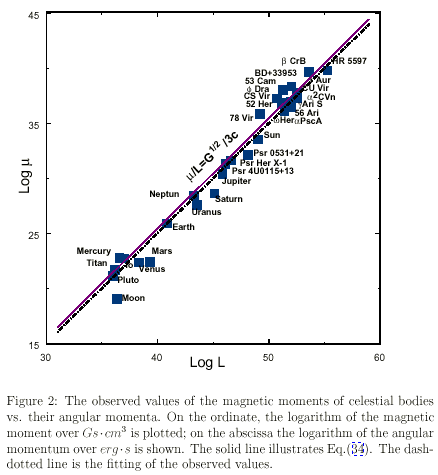
[figure 2 from astro-ph/0002048]
... Only the data for the Moon fall out, because its size is too small to create an electrically polarized core. ...
... Earlier models of the Earth assumed the existence of the monotonous dependence of pressure inside the planet. The division of the Earth into the core and the mantle was explained by the fact that at the creation of the Earth, on its share a certain amount of iron (and other heavy metals) and also a necessary amount of stone were given out. The core consists of metals and the mantle consists of stone. In these models, it was necessary to fit the parameters to get the densities of core and mantle and their sizes. It is not necessary to introduce any free parameters into the Earth theory based on the GIEP effect. Assuming that the Earth consists of homogeneous matter, the division on core and mantle is explained by the existence of the pressure jump on the surface of the core ... . The basic results of this theory are shown in Fig.1.
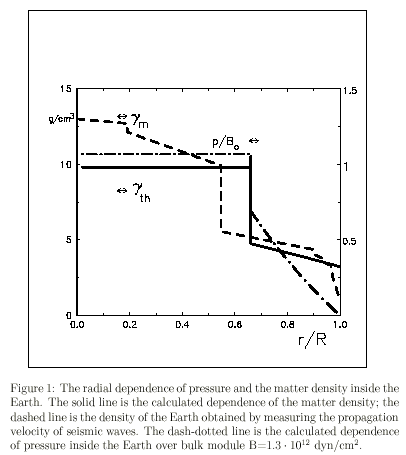
... In addition, from the obtained data it is possible to calculate the angular momentum of the Earth. This calculation gives the value of 0:339MR 2 . It is in agreement with the measured value of 0:331MR 2 within several percent of the accuracy. ...".
In his book Black Holes and Time Warps (Norton 1994) Kip Thorne says, on pages 429-430 and 432-433:
"... in June 1971 Zeldovich announced ... A spinning black hole must radiate ... a spinning metal sphere emits electromagnetic radiation ... The radiation is so weak ... that nobody has ever observed it, nor predicted it before. However, it must occur. The metal sphere will radiate when electromagnetic vacuum fluctuations tickle it. ... Zeldovich's mechanism by which vacuum fluctuations cause a spinning body to radiate. ... His sketch ...... showed a wave flowing toward a spinning object, skimming around its surface for a while, and then flowing away. The wave might be electromagnetic and the spinning body a metal sphere ... or the wave might be gravitational and the body a black hole ... The incoming wave is not a "real" wave ... but rather a vacuum fluctuation. ... the wave's outer parts ... are in the "radiation zone" while the inner parts are in the "near zone" ... the wave's outer parts move at ... the speed of light ... its inner parts move more slowly than the body's surface is spinning ... the rapidly spinning body will ... accelerate ...[the inner parts of the incoming wave] ... The acceleration feeds some of the body's spin energy into the wave, amplifying it. The new, amplified portion of the wave is a "real wave" with positive total energy, while the original, unamplified portion remains a vacuum fluctuation with zero total energy. ... Zeldovich ... proved that a spinning metal sphere radiates in this way; his proof was based on the laws of quantum electrodynamics ...".
B. G. Sidharth, in physics/9908004, says:
"... We first observe that as is known an assembly of Fermions below the Fermi temperature occupies each and every single particle level, and this explains the fact that it behaves like a distribution of Bosonic phonons: The Fermions do not enjoy their normal degrees of freedom. ... [there is a] Bosonization or semionic effect. ...Let us now consider an assembly of N electrons. As is known, if N+ is the average number of particles with spin up, the magnetisation per unit volume is given by
M = mu ( 2 N+ - N ) / V where mu is the electron magnetic moment. At low temperatures, in the usual theory, N+ = N / 2, so that the magnetisation ... is very small.
On the other hand, for Bose-Einstein statistics we would have, N+ = N.
With the above semionic statistics we have,
N+ = b N, 1/2 < b < 1, If N is very large, this makes an enormous difference ...
Let us use ... the case of Neutron stars. In this case, as is well known, we have an assembly of degenerate electrons at temperatures about 10^7 K, whereas the Fermi temperature is about 10^11 K ... So the above considerations apply. In the case of a Neutron star we know that the number density of the degenerate electrons, n = 10^31 per c.c. So ... remembering that mu = 10^(-20) G (Gauss), the magnetic field near the Pulsar is about 10^11 G < 10^8 Tesla, as required.
Some White Dwarfs also have magnetic fields. If the White Dwarf has an interior of the dimensions of a Neutron star, with a similar magnetic field, then remembering that the radius of a White Dwarf is about 10^3 times that of a Neutron star, its magnetic field would be 10^(-6) times that of the neutron star, which is known to be the case.
It is quite remarkable that the above mechanism can also explain the magnetism of the earth. As is known the earth has a solid core of radius of about 1200 kilometers and temperature about 6000 K. This core is made up almost entirely of Iron (90%) and Nickel (10%). It can easily be calculated that the number of particles N = 10^48 , and that the Fermi temperature is about 10^5 K. In this case we can easily verify ... that the magnetic field near the earth's surface is about 1 G, which is indeed the case.
It may be mentioned that the anomalous Bosonic behaviour ... would imply a sensitivity to external magnetic influences which could lead to effects like magnetic flips or reversals. ...
Remembering that the core density of Jupiter is of the same order as that of the earth, while the core volume is about 10^4 times that of the earth, we have in this case, N = 10^52 , so that the magnetization ... is about 10^4 times the earth's magnetism, as required. ....".
...